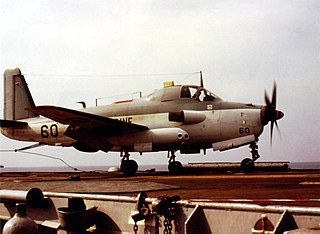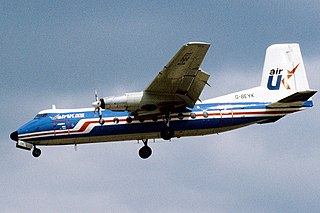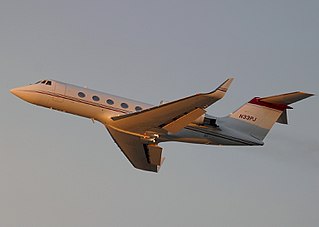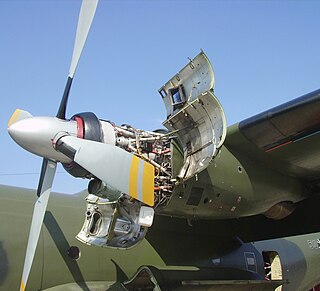Aviation Traders Limited (ATL) was a war-surplus aircraft and spares trader formed in 1947. In 1949, it began maintaining aircraft used by some of Britain's contemporary independent airlines on the Berlin Airlift. In the early 1950s, it branched out into aircraft conversions and manufacturing. During that period it also became a subcontractor for other aircraft manufacturers. By the end of the decade, it was taken over by the Airwork group.

The Airspeed AS.57 Ambassador is a British twin piston-engined airliner that first flew on 10 July 1947 and served in small numbers through the 1950s and 1960s. The planes are sometimes referred to as "Elizabethans", as they were originally ordered and popularised by British European Airways as the planes used for their "Elizabethan Class" passenger service.

The Aviation Traders ATL-98 Carvair was a large transport aircraft powered by four radial engines. It was a Douglas DC-4-based air ferry conversion developed by Freddie Laker's Aviation Traders (Engineering) Limited (ATL), with a capacity generally of 22 passengers in a rear cabin, and five cars loaded in at the front.

The Avro Canada C102 Jetliner was a Canadian prototype medium-range turbojet-powered jet airliner built by Avro Canada in 1949. It was beaten to the air by only 13 days by the de Havilland Comet, thereby becoming the second jet airliner in the world. The name "Jetliner" was chosen as a shortening of the term "jet airliner", a term which is still in popular usage. The aircraft was considered suitable for busy routes along the US eastern seaboard and garnered intense interest, notably from Howard Hughes who even offered to start production under license. However continued delays in Avro Canada's all-weather interceptor project, the CF-100 Canuck, led to an order to stop working on the project in 1951, with the prototype Jetliner later cut up for scrap.

The Vickers Viscount is a British medium-range turboprop airliner first flown in 1948 by Vickers-Armstrongs. A design requirement from the Brabazon Committee, it entered service in 1953 and was the first turboprop-powered airliner.

The Vickers Vanguard was a British short/medium-range turboprop airliner introduced in 1959 by Vickers-Armstrongs, a follow-up to its successful Viscount design with considerably more internal room. The Vanguard was introduced just before the first of the large jet-powered airliners, and was largely ignored by the market. Only 44 were built, ordered by Trans-Canada Air Lines (TCA) and British European Airways (BEA).

The Rolls-Royce RB.53 Dart is a turboprop engine designed and manufactured by Rolls-Royce Limited. First run in 1946, it powered the Vickers Viscount on its maiden flight in 1948. A flight on July 29 of that year, which carried 14 paying passengers between Northolt and Paris–Le Bourget Airport, in a Dart-powered Viscount was the first regularly scheduled airline flight by a turbine-powered aircraft. The Viscount became the first turboprop powered aircraft to enter airline service with British European Airways (BEA) in 1950.

The Hawker Siddeley HS 780 Andover is a twin-engined turboprop military transport aircraft produced by Hawker Siddeley for the Royal Air Force (RAF), developed from the Avro-designed HS 748 airliner. The Andover was named after the Avro Andover, a biplane transport used by the RAF for medical evacuation between the first and second world wars; and RAF Andover, where some of its trials were carried out. The Andover had a kneeling landing gear to make ramp loading easier.

The Bréguet Br.1050 Alizé was a French carrier-based anti-submarine warfare aircraft. It was developed in the 1950s, based loosely on the second prototype Bréguet Vultur attack aircraft which had been modified into the Bréguet Br.965 Épaulard anti-submarine warfare aircraft.

The Grumman Gulfstream I is a twin-turboprop business aircraft. It first flew on August 14, 1958.

The Handley Page Dart Herald is a 1950s British turboprop passenger aircraft.

The Gulfstream II (G-II) is an American twin engine business jet designed and built by Grumman and then in succession, Grumman American and finally Gulfstream American. Its Grumman model number is G-1159 and its US military designation is C-11 Gulfstream II. It has been succeeded by the Gulfstream III. The first Gulfstream II flew on October 2, 1966.

The Rolls-Royce RB.109 Tyne is a twin-shaft turboprop engine developed in the mid to late 1950s by Rolls-Royce Limited. It was first test flown during 1956 in the nose of a modified Avro Lincoln. Following company naming convention for gas turbine engines this turboprop design was named after the River Tyne.

The Avro Type 688 Tudor was a British piston-engined airliner based on Avro's four-engine Lincoln bomber, itself a descendant of the famous Lancaster heavy bomber, and was Britain's first pressurised airliner. Customers saw the aircraft as little more than a pressurised DC-4 Skymaster, and few orders were forthcoming, important customers preferring to buy US aircraft. The tailwheel undercarriage layout was also dated and a disadvantage.

The ANEC III was a 1920s British six-seat passenger and mail carrier aircraft built by Air Navigation and Engineering Company Limited at Addlestone, Surrey.

The Avro 701 Athena is a British advanced trainer aircraft built by Avro in the late 1940s. It was designed to replace the North American Harvard in the Royal Air Force, but was bought only in small numbers, the competing Boulton Paul Balliol being preferred.

The Armstrong Whitworth AW.55 Apollo was a 1940s British four-engine turboprop airliner built by Armstrong Whitworth at Baginton. The aircraft was in competition with the Vickers Viscount but was beset with engine problems and only two were built.

The Fairey N.9 was a British experimental floatplane of the First World War; only one was built. It carried out the first shipborne catapult launches from Royal Navy ships, and was later sold to Norway.

The MSW Votec 322 is a Swiss two-seat low-wing monoplane based on the Rihn DR-107 One Design and designed for amateur construction by MSW Aviation of Wohlen.

The SNCASE SE-1010 was a late 1940s French photo-survey aircraft designed and built by SNCASE for the Institut Géographique National, one prototype was built but it crashed and the project was cancelled.



















